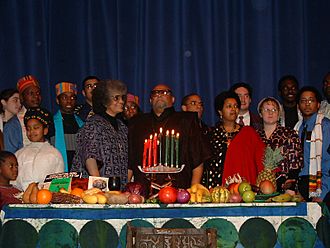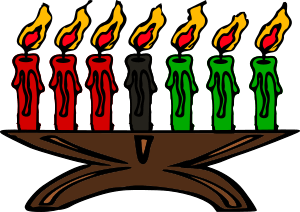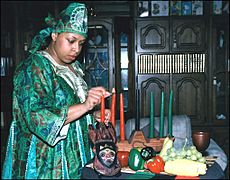Kwanzaa facts for kids
Quick facts for kids Kwanzaa |
|
|---|---|

Kwanzaa celebration with its founder, Maulana Karenga, and others
|
|
| Observed by | African Americans |
| Type | Cultural and ethnic |
| Significance | Celebrates Black heritage, unity and culture. |
| Celebrations | Unity Self-Determination Collective Work and Responsibility Cooperative Economics Purpose Creativity Faith |
| Date | December 26 until January 1 |
| Related to | Black History Month |
Kwanzaa is a special week-long celebration in the United States. It honors African heritage and culture. During Kwanzaa, people light a kinara, which is a candle holder with seven candles. They also give each other gifts. This celebration happens every year from December 26 to January 1. It was started by Maulana Karenga and was first celebrated in 1966. Some people who are not African American also celebrate Kwanzaa. A common greeting for the holiday is "Joyous Kwanzaa."
Contents
What is Kwanzaa and Why Was It Started?
Kwanzaa began in the 1960s. It was created to help African Americans reconnect with their African cultural and historical roots. It was a way to celebrate their identity and traditions.
When Kwanzaa first started, its founder, Maulana Karenga, wanted it to be a unique celebration for African Americans. Over time, as Kwanzaa grew more popular, Karenga changed his view. He wanted to make sure that Christians could also feel included in the celebration.
Where Does the Name Kwanzaa Come From?
The name Kwanzaa comes from the Swahili phrase matunda ya kwanza. This phrase means "first fruits." Many "first fruits" festivals are celebrated in Southern Africa, usually in December or January. These festivals often happen around the time of the southern solstice.
Maulana Karenga was inspired by some of these African festivals. He read about the Zulu festival called Umkhosi Wokweshwama. He decided to spell the holiday's name with an extra "a" at the end. This was done so the name would have seven letters, which is a symbolic number for the holiday.
What Are the Seven Principles of Kwanzaa?
Kwanzaa celebrates seven important ideas. These are called the seven principles of Kwanzaa, or Nguzo Saba in Swahili. Each of the seven days of Kwanzaa is dedicated to one of these principles:
- Umoja (Unity): This means working to keep unity strong in the family, community, nation, and among all people.
- Kujichagulia (Self-Determination): This principle is about defining yourselves, naming yourselves, creating for yourselves, and speaking for yourselves.
- Ujima (Collective Work and Responsibility): This means building and taking care of your community together. It's about making sure everyone's problems are shared and solved as a group.
- Ujamaa (Cooperative Economics): This principle encourages building and supporting your own stores, shops, and businesses. The goal is to profit from them together as a community.
- Nia (Purpose): This means making your main goal to build and develop your community. It's about helping your people return to their traditional greatness.
- Kuumba (Creativity): This principle is about always doing your best. It means leaving your community more beautiful and better than you found it.
- Imani (Faith): This means believing with all your heart in your people, your parents, your teachers, your leaders, and in the rightness and success of your efforts.
What Symbols and Traditions Are Part of Kwanzaa?
There are several important symbols used during Kwanzaa. These include:
- A decorative mat where other symbols are placed.
- Corn and other crops.
- A candle holder with seven candles, called a kinara.
- A communal cup for pouring libations (a drink poured as an offering).
- Gifts.
- A poster showing the seven principles.
- A flag with black, red, and green colors.
These symbols are designed to represent the seven principles of Kwanzaa.
During Kwanzaa, families decorate their homes with art. They often use colorful African cloth, like kente. Women might wear kaftans. Fresh fruits that represent African ideas are also used. It is common for children to be included in Kwanzaa ceremonies. People also show respect and thanks to their ancestors.
A special drink, called a libation, is often shared. This is usually done with a common chalice (a shared cup) called Kikombe cha Umoja. This cup is passed around to everyone present.
A Kwanzaa ceremony can include drumming and music. It might also feature libations, a reading of the African Pledge, and the Principles of Blackness. People reflect on the Pan-African colors (black, red, and green). They discuss the African principle of the day or a chapter in African history. There is also a candle-lighting ritual, artistic performances, and finally, a feast (Karamu). The greeting for each day of Kwanzaa is Habari Gani?, which means "What's the news?" in Swahili.
Cultural events, like "The Spirit of Kwanzaa," are also held. These events feature interpretive dance, African dance, songs, and poetry.
Interesting Facts About Kwanzaa
- In the kinara, the one black candle represents the unity of the people.
- The three green candles represent the future of African lands and communities.
- The three red candles represent the past struggles and sacrifices of African ancestors.
- The first US postage stamp to recognize Kwanzaa was issued in 1997.
- Kwanzaa is a cultural holiday, not a religious one.
Images for kids
-
A 2003 Kwanzaa celebration with Kwanzaa founder Maulana Karenga at the center, and others
See also
 In Spanish: Kwanzaa para niños
In Spanish: Kwanzaa para niños






